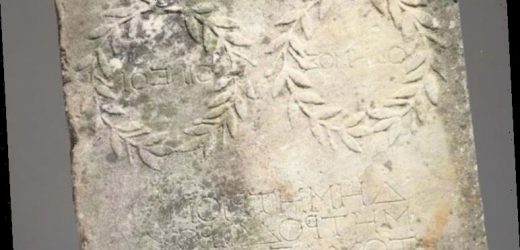Roman Tunisia settlement archaeology is 'enigma' says expert
A woman in Hampshire was shocked to discover that a slab of rock she has been using for 20 years is actually worth £10,000 to £15,000. The anonymous woman discovered the slab two decades ago and has been using it as a stepping stone for her stable. However, after the years washed away some of the debris on its surface, she noticed strange carvings on the face of the rock.
The carvings were of a laurel wreath carved into the marble rock.
After having it professionally checked by a local archaeologist, the woman was stunned the object stems from the second century AD.
Experts believe it either has Greek or Asian origins and may have been transported to these shores two centuries ago.
An inscription beneath the wreath reads, in Greek: “The people (and) the young men (honour) Demetrios (son) of Metrodoros (the son) of Leukios.”
We will use your email address only for sending you newsletters. Please see our Privacy Notice for details of your data protection rights.
Following the discovery, the woman has looked to cash in on the object, with it set to be auctioned by auctioneers Woolley and Wallis.
The auctioneers hope to use the publicity to determine where the slab came from.
Antiquities specialist Will Hobbs at Woolley and Wallis said: “Artefacts of this type often came into England as the result of Grand Tours in the late 18th and 19th century, when wealthy aristocrats would tour Europe learning about Classical art and culture.
“We assume that is how it entered the UK, but what is a complete mystery is how it ended up in a domestic garden, and that’s where we’d like the public’s help.”
The row of cottages in which the slab was initially found was built in the 1960s.
The team hopes someone who perhaps lived in the area at the time, or who worked on the construction, might recall the origins of some of the rubble used.
Mr Hobbs continued: “There are several possibilities of where the stone might have originated.
“Both Cowesfield House and Broxmore House were very close to Whiteparish and were demolished in 1949 after having been requisitioned by the army during the war.
“But we also know that the house at what is now Paulton’s Park was destroyed by fire in 1963 and so possibly rubble from there was reused at building sites in the area shortly afterwards.”
DON’T MISS
Skeletal remains uncovered in hunt for nuns killed by Soviets in 1945
Mayan breakthrough: ‘Snapshot’ of secret civilisation uncovered
Archaeology discovery: Missing piece of ‘England’s greatest treasure’
The news comes on the back of a discovery from a birdwatcher was lucky enough to find more than 1,300 coins dating to around 40 to 50 CE.
The coins were of Celtic origin and experts valued them at roughly £650 each, meaning he had discovered a collection worth £845,000.
The anonymous man told Treasure Hunting Magazine: “Although I am a keen detectorist, that evening I was doing a bit of bird watching.
“After watching a dogfight between a buzzard and a pair of Magpies, I stared down and spotted something lying in a bit of the deep ploughed soil which ran around the edge of the field.
“I saw the glint of gold and realised it was a beautiful Celtic gold stater, which made me sit down in sheer shock. I then spotted the second coin two feet away and rushed home to get my [metal detector].”
Source: Read Full Article






